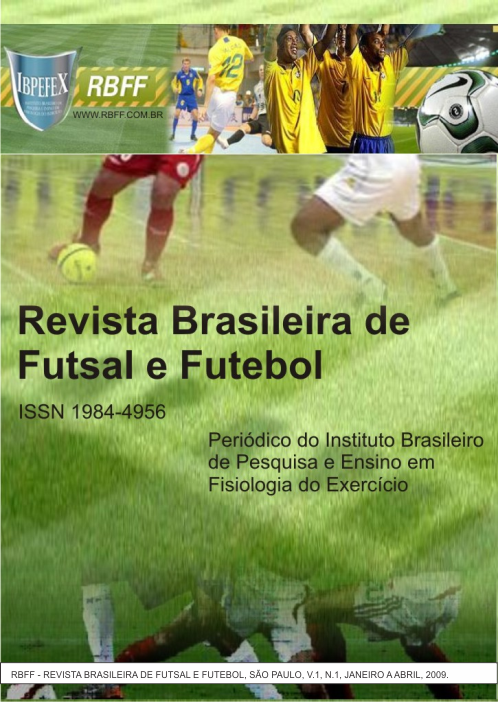Effects of a pre-season interval training on maximal oxygen consumption and mean velocity in professional footbal players
Abstract
During footbal game players can cover a distance of approximately 10 to 12 km, in a mean intensity proximal to anaerobic threshold. The objective of the present study was to evaluate the efficiency of a pre-season complementary interval training of four weeks on VO2max and mean velocity in professional soccer players. 17 male players aged 23 ± 3.3 years old were selected. Before and after the intervention a 2400m test was performed for VO2max estimation. The interval training consisted of 4 running sets lasting 4 minutes at mean velocity obtained in the 2400m test, with active recovery of 3 minutes at 75% of the mean velocity. To verify the difference between the two moments, paired Student t test was done, with p≤0.05. With regard to VO2max, there was a mean increase of 5.4% or 2.61 ml/kg/min-1 (p=0.02); 5.3% or 7.59 ml/kg-0.75/min-1 (p=0.03), after four weeks of training in comparison with pre-training values. On the other hand, in VO2max expressed by l/min no statistical significant difference was observed between the pre and post-test. Mean velocity presented a significant increase of 5.2% from pre to post-test (p=0.02). It was concluded that the additional interval training protocol of four weeks was efficient in increasing VO2max and mean velocity. These results are interesting in practice, due to little available time to improve velocity and aerobic capacity in the initiation of the season.
References
- Bangsbo, J. The physiology of soccer: with special reference to intense intermittent exercise. Acta Physiology Scandinavian Suppl. 1994; 619:1-155.
- Bangsbo, J.; Lindquist, F. Comparison of various exercise tests with endurance performance during soccer in professional players. International Journal Sports Medicine 1992;13:125-32.
- Basset, D.R.Jr.; Howley, E.T. Limiting factors for maximum oxygen uptake and determinants of endurance performance. Medicine Science Sports Exercise. 2000;32:70-84.
- Esposito, F.; Impellizzeri, F.M.; Margonato, V.; Vanni, R, Pizzini, G.; Veicsteinas, A. Validity of heart rate as an indicator of aerobic demand during soccer activities in amateur soccer players. European Journal Applied Physiology 2004;93:167-72.
-Helgerud, J.; Engen, L.C.; Wisloff, U.; Hoff, J. Aerobic endurance training improves soccer performance. Medicine Science Sports Exercise., 2001;11:1925–31.
- Hoff, J.; Helgerud, J. Endurance and strength training for soccer players. Physiological considerations. Sports Medicine. 2004;34:165–80.
- Hoff, J.; Wisløff, U.; Engen, L.C.; Kemi, O.J.; Helgerud, J. Soccer specific aerobic endurance training. British Journal of Sports Medicine. 2002; 36:218-221.
- Chamari, K.; Hachana, Y.; Kaouech, F.; Jeddi, R.; Moussa-Chamari, I.; Wisløff, U. Endurance training and testing with the ball in young elite soccer players. British Journal of Sports Medicine 2005; 39;24-28.
- Chamari, K.; Hachana, Y.; Ahmed, Y.B.; Galy, O.; Sghaïer, F.; Chatard, J.C.; e colaboradores. Field and laboratory testing in young elite soccer players. Sports Medicine, 2004; 35(6):501-536.
- McMillan, K.; Helgerud, J.; Macdonald, R.; Hoff, J. Physiological adaptations to soccer specific endurance training in professional youth soccer players. British Journal of Sports Medicine. 2005a;39:273–277.
- McMillan, K.; Helgerud, J.; Grant, S.J.; Newell, J.; Wilson, J.; Macdonald, R.; Hoff, J. Lactate threshold responses to a season of professional British youth soccer. British Journal of Sports Medicine. 2005b;39:432-436.
- Lima, A.M.J.; Silva, D.V.G.; Souza, A.O.S. Correlação entre as medidas direta e indireta do VO2max em atletas de futsal. Revista Brasileira de Medicina do Esporte 2005;11(3): 164-166.
- Reilly, T. Physiological profile of the player, in Ekblom B (ed): Football (Soccer). Oxford, Blackwell Scientific Publications, 1994;78–94.
- Wisloff, U.; Helgerud, J.; Hoff, J. Strength and endurance of elite soccer players. Medicine Science Sports and Exercise. 1998;30:462–7.
- Tahara, Y.; Moji, K.; Tsunawake, N.; Fukuda, R.; Nakayama, M.; Nakagaichi, M.; e colaboradores. Physique, Body Composition and Maximum Oxygen Consumption of Selected Soccer Players of Kunimi High School, Nagasaki, Japan. Journal of Physiological Anthropology 2006; 25(4):291-297.
Authors who publish in this journal agree to the following terms:
- Authors retain the copyright and grant the journal the right of first publication, with work simultaneously licensed under the Creative Commons Attribution License BY-NC which allows the sharing of the work with acknowledgment of the authorship of the work and initial publication in this journal.
- Authors are authorized to enter into additional contracts separately for non-exclusive distribution of the version of the work published in this journal (eg, publishing in institutional repository or book chapter), with acknowledgment of authorship and initial publication in this journal.
- Authors are allowed and encouraged to post and distribute their work online (eg, in institutional repositories or on their personal page) at any point before or during the editorial process, as this can bring about productive change as well as increase impact and impact. citation of published work (See The Effect of Free Access).





